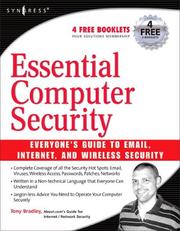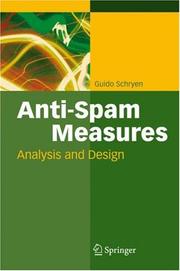| Listing 1 - 2 of 2 |
Sort by
|

ISBN: 1281071862 9786611071868 0080505899 1597491594 1597491144 1429417668 9781429417662 9781597491143 9781597491594 9780080505893 9780080505893 Year: 2006 Publisher: Rockland, MA : Syngress Publishing,
Abstract | Keywords | Export | Availability | Bookmark
 Loading...
Loading...Choose an application
- Reference Manager
- EndNote
- RefWorks (Direct export to RefWorks)
Essential Computer Security provides the vast home user and small office computer market with the information they must know in order to understand the risks of computing on the Internet and what they can do to protect themselves.Tony Bradley is the Guide for the About.com site for Internet Network Security. In his role managing the content for a site that has over 600,000 page views per month and a weekly newsletter with 25,000 subscribers, Tony has learned how to talk to people, everyday people, about computer security. Intended for the security illiterate, Essential Computer Securit
Computer networks - Security measures. --- Computer security. --- Computers --- Electronic mail systems --- Firewalls (Computer security) --- Internet --- Spam filtering (Electronic mail) --- Spyware (Computer software) --- Access control --- Passwords. --- Security measures. --- Blocking, Spam (Electronic mail) --- Filtering, Spam (Electronic mail) --- Slamming spam (Electronic mail) --- Spam blocking (Electronic mail) --- Spam slamming (Electronic mail) --- Computer firewalls --- Internet firewalls --- Intranet firewalls --- Passwords in computer access control --- Computer privacy --- Computer system security --- Computer systems --- Cyber security --- Cybersecurity --- Electronic digital computers --- Security of computer systems --- Security measures --- Protection of computer systems --- Protection --- Malware (Computer software) --- Filters (Mathematics) --- Computer networks --- Data protection --- Security systems --- Hacking

ISBN: 1281043451 9786611043452 3540717501 354071748X 3642090877 Year: 2007 Publisher: Berlin ; New York : Springer,
Abstract | Keywords | Export | Availability | Bookmark
 Loading...
Loading...Choose an application
- Reference Manager
- EndNote
- RefWorks (Direct export to RefWorks)
The primary goal of this work is the methodical analysis of the potential, limitations, advantages, and drawbacks of anti-spam measures. These determine to which extent the measures can contribute to the reduction of spam in the long run. The range of considered anti-spam measures includes legislative, organizational, behavioral and technological ones. Furthermore, the conceptual development and analysis of an infrastructural email framework that features such a complementary application, is pointed out. After the presentation of the technological and organizational facets, the framework is analyzed twofold: its theoretical effectiveness is assessed with the aid of the formal model mentioned above, its storage and traffic requirements are analyzed quantitatively. The author further considers deployment issues, as the framework will have to be integrated in both the technological and the organizational Internet infrastructure. About the author: Guido Schryen graduated from the RWTH Aachen University (Germany) with a Master’s degree in Computer Science and a Master’s degree in Operations Research. He obtained his PhD from the Faculty of Business Administration and Economics at the RWTH Aachen University, where he now holds a postdoc position at the Institute of Information Systems. His current research activities focus on Internet security and anti-spam measures. Features & Benefits: It provides a comprehensive overview of the state-of-the-art of the anti-spam field. It includes a description and a methodical analysis of a broad range of technological, organizational, behavioral, and legislative anti-spam measures. It empirically shows how email addresses on the Internet are harvested and used for spamming. Presents a technological and organizational email infrastructure framework for long-term prevention of email spam. .
Spam filtering (Electronic mail) --- Spam (Electronic mail) --- Prevention. --- Electronic junk mail --- Junk electronic mail --- Spamming (Electronic mail) --- Unsolicited electronic mail messages --- Unwanted electronic mail --- Electronic mail messages --- Blocking, Spam (Electronic mail) --- Filtering, Spam (Electronic mail) --- Slamming spam (Electronic mail) --- Spam blocking (Electronic mail) --- Spam slamming (Electronic mail) --- Electronic mail systems --- Filters (Mathematics) --- Security measures --- Information systems. --- Computer security. --- Software engineering. --- Information Systems. --- Information Systems Applications (incl. Internet). --- Information Systems and Communication Service. --- Systems and Data Security. --- Software Engineering/Programming and Operating Systems. --- Management of Computing and Information Systems. --- Computer software engineering --- Engineering --- Computer privacy --- Computer system security --- Computer systems --- Computers --- Cyber security --- Cybersecurity --- Electronic digital computers --- Protection of computer systems --- Security of computer systems --- Data protection --- Security systems --- Hacking --- Protection --- Application software. --- Computers. --- Management information systems. --- Computer science. --- Informatics --- Science --- Computer-based information systems --- EIS (Information systems) --- Executive information systems --- MIS (Information systems) --- Sociotechnical systems --- Information resources management --- Management --- Automatic computers --- Automatic data processors --- Computer hardware --- Computing machines (Computers) --- Electronic brains --- Electronic calculating-machines --- Electronic computers --- Hardware, Computer --- Cybernetics --- Machine theory --- Calculators --- Cyberspace --- Application computer programs --- Application computer software --- Applications software --- Apps (Computer software) --- Computer software --- Communication systems
| Listing 1 - 2 of 2 |
Sort by
|

 Search
Search Feedback
Feedback About UniCat
About UniCat  Help
Help News
News